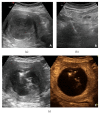Percutaneous High Frequency Microwave Ablation of Uterine Fibroids: Systematic Review
- PMID: 29511672
- PMCID: PMC5817312
- DOI: 10.1155/2018/2360107
Percutaneous High Frequency Microwave Ablation of Uterine Fibroids: Systematic Review
Abstract
Uterine fibroids are the most common benign pelvic tumor of the female genital tract and tend to increase with age; they cause menorrhagia, dysmenorrhea, pelvic pressure symptoms, back pain, and subfertility. Currently, the management is based mainly on medical or surgical approaches. The nonsurgical and minimally invasive therapies are emerging approaches that to the state of the art include uterine artery embolization (UAE), image-guided thermal ablation techniques like magnetic resonance-guided focused ultrasound surgery (MRgFUS) or radiofrequency ablation (RF), and percutaneous microwave ablation (PMWA). The purpose of the present review is to describe feasibility results and safety of PMWA according to largest studies available in current literature. Moreover technical aspects of the procedure were analyzed providing important data on large scale about potential efficacy of PMWA in clinical setting. However larger studies with international registries and randomized, prospective trials are still needed to better demonstrate the expanding benefits of PMWA in the management of uterine fibroids.
Figures


References
-
- Ravina J., Aymard A., Ciraru-Vigneron N., Clerissi J., Merland J. Arterial embolization: a new treatment of uterine myomata in young women. International Journal of Gynecology & Obstetrics. 2000;70:C26–C26. doi: 10.1016/S0020-7292(00)81490-3. - DOI
Publication types
MeSH terms
LinkOut - more resources
Full Text Sources
Other Literature Sources
Medical

